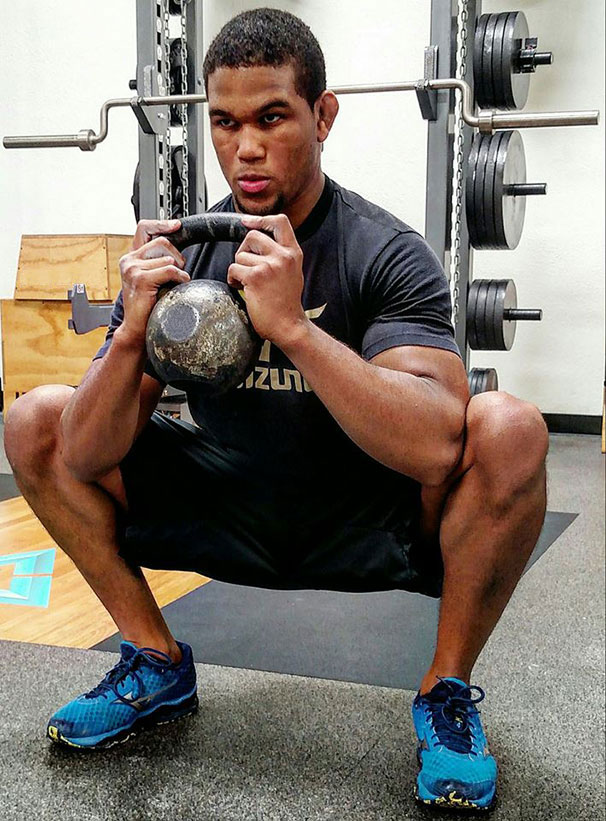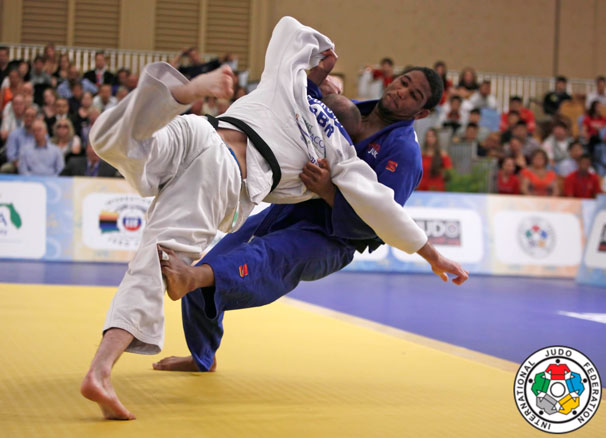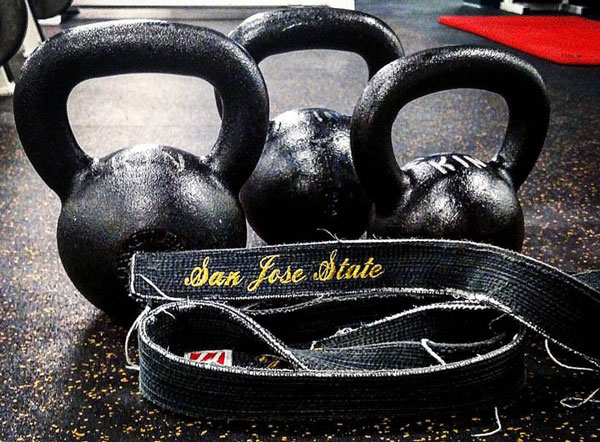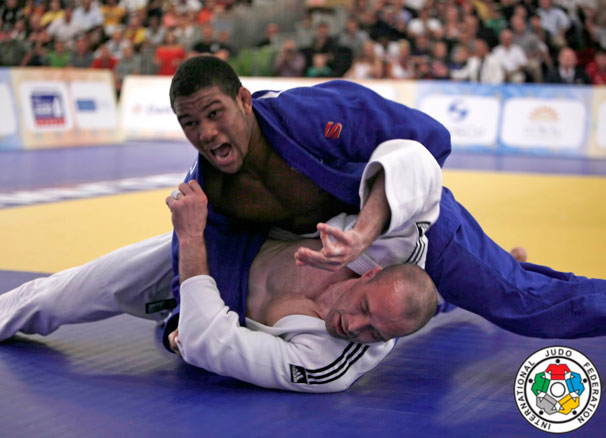
10,000 athletes compete in the Summer Olympics. Colton Brown, age 23, was ranked number 1 in the USA (and 27th in the world) in the Men’s 90 Kilogram Judo Black Belt Division on May 30, 2016. Now, Colton is heading to the 2016 Summer Olympics in Rio De Janeiro to represent the USA.
The road to Rio was not easy, but Colton’s USA Olympic Judo Team qualification was one of the proudest moments in my young career as a strength coach. After four years of hard work, Colton has manifested a dream he’s had since age 12.
Colton had just returned from competing in the World Judo Championships in Rio De Janeiro, Brazil when I first began working with him in August of 2013. I had just begun my coaching career by volunteering as the Spartan Judo Team strength coach at San Jose State University. As a dominant collegiate Judo athlete and 2-time All American, Colton had his sights set on becoming an Olympian. After the World Judo Championships, Colton wanted to gain muscle mass. We spent the Fall semester in the weight-room working on a basic hypertrophy program. With the 2016 Olympic qualification period nine months away, we planned to spend two-thirds of the year on strength and hypertrophy. By mid-November, Colton had made significant strength and size gains.
Colton then traveled to Texas and Japan, two of 2013’s last important tournaments. At the Tokyo Grand Slam Tournament, he reported standing toe to toe with the number four competitor in the world—and he only lost by a penalty. Colton won six matches and took the gold medal at the Dallas Open. He credits our weight training program for helping him become the best player in the country.
After the tournaments, Colton kept training on campus at San Jose State, he also trained with me privately two to three times each week at the facility. Even before he began working with me, Colton already had a great deadlift, crushed pull-ups, and push-ups with ease. But, Colton’s weakest lift was the squat. While we had addressed his movement patterns and mobility, the exercise which ultimately helped Colton improve his squat was the goblet squat.
Since late 2014, the goblet squat has been a staple of Colton’s training. At first, I used it as a tool to teach Colton to squat more efficiently, and to build a strong foundation. Next, we progressed to the barbell back squat, double kettlebell front squat, and many others. I believe goblet squats are a great exercise for athletic movement preparation, or as a stand-alone drill for mobility.
Most importantly, the goblet squat is a great in-season squat patterning exercise for all athletes. Judo athletes face a unique programming challenge—their entire year is “in-season”. There’s no true “off season”, especially at the international level. Judo athletes compete and train on a regular basis. Even during the “slower” parts of the year, they practice on the mat twice a day, for five to six days each week. During the qualification period, they frequently travel for qualifying tournaments and required training camps. Extra travel is another unique programming challenge.
Goblet squats have a high benefit to low-risk ratio. I am not comfortable placing a lot of load on my Judo athletes during certain times of the year with barbell back squats, or front squats. Regardless of the competition calendar, I can always turn to the goblet squat—it’s safe, effective, and works well in our training program.

The Road to Rio
In April 2014, Colton won his third consecutive title at the National Collegiate Judo Championships and continued to establishing himself as the one of the best Judo players in the USA. Shortly after, the Olympic qualification period began in May 30, 2014 and lasted until May 30, 2016. Prior to qualification, we made sure to build a solid base of strength. With more travel, we adjusted the volume of Colton’s program while he competed all over the world.
The World Tour is tough on Judo athletes. It’s stressful, and while they get to see the world, it’s not a vacation. Standing are constantly changing, qualification points are on the line—along with the demands of competing and traveling in vastly different environments all over the world. It’s a grind.
During the two-year qualification period, I added kettlebell training to many of Colton’s workouts. The kettlebell can profoundly benefit elite level Judo athletes. Kettlebell training is one of the most important ingredients in our recipe for success. While I don’t use kettlebells exclusively in my programs, they have proven time and time again to benefit our athletes on the Judo mat. Kettlebell swings may be one of the best movements a Judoka can perform in the weight room. Since adding more swings to Colton’s training sessions in the Spring of 2014, they have remained a staple in his training as a go-to power exercise.
We needed to train Colton to be as strong and healthy as possible to endure the intense training camps and international Judo tournaments. While Colton had less time to train with me, our general programming template remained the same. For the three years we’ve been training, I’ve tried to use as many “big bang for your buck” movements in his training—no matter what tool we use.
Big Bang For Your Buck Movements
- Push (horizontal and vertical)
- Pull (horizontal and vertical)
- Hinge (bilateral and unilateral)
- Squat (bilateral and unilateral)
- Crawling (side to side, forwards, backwards)
- Core training
- Movement in the sagittal, frontal, and transverse planes
Colton’s programs included balanced workouts with a wide variety of exercises with barbells, TRX, medicine balls, dumbbells, and kettlebells. For example, in one workout we would focus on a hinge movement and a pushing movement, then the next workout would feature a squatting movement and a pulling movement. I also included mobility, core training, and accessory movements in every session. Occasionally, we took the training to the beach or park. I think it’s important to include variety in your training and training environment. Another reason I love the kettlebell is you can work out with it almost anywhere.
Making the USA Olympic Judo Team
Colton continued to train relentlessly both on and off the Judo mat during the qualification period. During that time, he won a Gold Medal in the Pan American Open in San Salvador, Silver Medals at the European Open in Glasgow and African Open in Tunis, and placed at many other renowned tournaments throughout the world.
At the prestigious Pan American Championships in Havana, Cuba in May 2016, Colton earned three wins with one loss, capturing a Silver Medal after finishing in fifth-place for the previous two years. Now, Colton will be one of only three men representing the United States Judo Team in Rio De Janeiro this August.
Daily, Colton spends countless hours on the mats perfecting his judo technique, dialing in his nutrition, practicing mental visualization, planning his recovery, and studying his opponents. He also gives his best in every strength and conditioning session.
Kettlebell Swings and the Goblet Squat for Judo Performance
The Goblet Squat
The goblet squat is a staple in almost all of Colton’s strength and conditioning programs for the past two and a half years. Since there’s no true off-season in Judo, I have to be smart about loading him up. While we use other squat variations with the barbell, the goblet squat is our go-to.
Goblet Squat Prying
After a two to three week hiatus due to travel, goblet squat prying was an excellent choice to help open his hips. Flying has a direct physical impact. Sitting can cause the hip flexors and hamstrings to get tight and stiff. It can also take a toll on the spine, hips, and shoulders. Long flights leave your legs tight and your glutes inactive. One of the mobility drills I learned at the HKC is goblet squat prying, and it is incredibly effective for loosening up the hips.
I instruct the athlete to breathe deeply while maintaining their posture. As they begin to loosen up, I will instruct them to go deeper into the squat while wiggling the hips from side to side and in a small figure-8 as taught at the HKC. Alternately, I will instruct them to hold the bottom of the goblet squat position for a count of 10 breaths. We often superset the prying goblet squat with the RKC hip flexor stretch. These two exercises can do wonders for the hips, especially after a long flight. Adding a few sets of mini band activation exercises such as bent knee lateral walks, and mini band glute bridges ensure glute engagement. After opening up the hips, stretching the hip flexors, and turning on the glutes, the athlete is ready for a more productive training session.
The Goblet Squat as a “Mini Screen”
While I’m certified to use the FMS screen and administer it throughout the year, I also use the goblet squat in warm-ups and as a quick daily screen. Goblet squats how me how the athlete is moving during that particular training session. Basic movements like lunges, push ups, and squatting patterns can be used as movement preparation for the training session and as “mini screens”. I want to get a picture of where the athlete is on that given day, along with any flaws or leaks in the movement.
The Goblet Squat as a Teaching Aide
The goblet squat reinforces correct squatting mechanics. Colton’s squatting pattern, squat depth, and mobility immediately improved after adding the goblet squat to his program. The goblet squat is one of the best tools for helping my Judo athletes develop movement competency in the squatting pattern. I’m more confident when progressing them to advanced squatting variations such as barbell front squats, or racked kettlebell front squats.

The Kettlebell Swing
Powerful hip hinging movements teach athletes how to load their hips rather than their spine. They learn better ground force production while building a strong posterior chain (back, butt, abs, and hamstrings). For these reasons alone, the swing is always at the top of my exercise selection list for Judo athletes. I almost always some type of kettlebell swing in their programs. Russian wrestlers have used kettlebells for years and recognized the carryover onto the wrestling mats. I think the kettlebell swing is one of the best conditioning choices for grapplers and other combat sport athletes.
Hip Hinge
Moving comfortably and efficiently from the hip is important for the proper execution of throws and other movements in Judo. The main movements in the hip hinge are bending (flexion) and straightening (hip extension) when standing back up. A good Judo athlete must be able to properly hinge from the hips when setting up for or defending a takedown. I have seen a direct carryover from the explosive hip snap action of swinging kettlebells to the mat, especially for throwing.
Colton told me, “Judo is 90% hips, so when there’s a lot of kettlebell swings in my program my hips feel powerful—especially in my defense. When guys come in and try to throw me forward, I’m able to use my hips to block throws a lot more effectively.” Every time Colton sets up for kettlebell swings, he has to start from an athletic position before hiking the kettlebell back. Anytime your athletes can practice getting into the athletic position during training you’re on to something good. In grappling, the athletic position is critical for defending and blocking throws.
Grip
A kettlebell’s thick handle challenges the grip—another reason that kettlebells can greatly benefit the Judoka. If you’re doing a lot of swings, you’re also spending a lot of time building a vise-like grip. I experienced kettlebell-enhanced grip strength in my own Jiu-Jitsu practice when gripping my opponent’s gi. During the months of preparation leading up the HKC, I developed a better grip which was immediately apparent at my Jiu-Jitsu class.

There are many ways to grip the gi in Judo and Jiu-Jitsu not only on the lapel and sleeves, but also on the pants and various parts of the jacket—sometimes even the belt. Once you achieve a good grip, you don’t want to lose it. “Without a good grip, Judo does not work” (Pedro, 2001 p48). Swings are just one of many kettlebell exercises (loaded carries, heavy get ups, presses, etc.) you can use to develop a strong grip. It is important to note that you can have the strongest grip in the world, but if you’re holding on to the wrong things, it does not help in Judo. Efficient gripping is addressed in the specific physical preparation of Judo practice, and should be complemented with supplemental grip strengthening exercises in a strength and conditioning program.
Tension and Relaxation
Some Judokas are too relaxed—and they are easily thrown. Others aren’t relaxed enough, and they ultimately burn more energy and fatigue more quickly than their opponent during the match. At the top of the kettlebell swing, all of your muscles must contract to allow the kettlebell to float briefly and then quickly relax so you can begin the backswing. The tension/relaxation principle taught in Hardstyle kettlebell training is incredibly valuable for the Judoka. Throughout a Judo match there is a constant—almost yin and yang like—balance between relaxation and tension. When working with Colton on his swings, I regularly reminded him to create tension at the top of each swing with the cues “tight abs” and “tight glutes”. At the same time I also checked for a full exhale, and during the backswing I would remind him to “relax”.
One principle from Hardstyle kettlebell training that I continually drive home with my Judo athletes is the transition between tension and relaxation. Kettlebell swings allow athletes to quickly create maximal amounts of tension followed by relaxation. This is a skill that can be transferred into almost any throw attempted on the mat.
Final Thoughts
Kettlebell training has played a big part in Colton Brown’s physical preparation for the Olympics, and I believe that kettlebell training is of particular benefit for anyone involved in martial arts such as Judo, Brazilian Jiu-Jitsu, and Muay Thai. This also holds true for any other type of combat sport like wrestling, boxing, or MMA.
Resources:
- Bakken, J. (2012, July 23). A journey of Olympic proportions begins with a determined step. Retrieved June 03, 2016, from https://www.uab.edu/news/latest/item/2599-a-journey-of-olympic-proportions-begins-with-a-determined-step
- Pedro, J., & Durbin, W. (2001). Judo techniques & tactics. Champaign, IL: Human Kinetics.
More about Judo Athlete Colton Brown:
****
Ashoka McCormick, HKC, NASM-CPT, FMSC, CFSC works at Paradigm Sport Elite Athlete Training Center in Santa Cruz, CA, and he also serves as the Volunteer Strength & Conditioning Coach for SJSU Judo. He can be contacted at coachashoka@gmail.com. Please mention HKC in the subject. Connect with Ashoka McCormick on LinkedIn or follow him on Instagram: @ashoka_trains